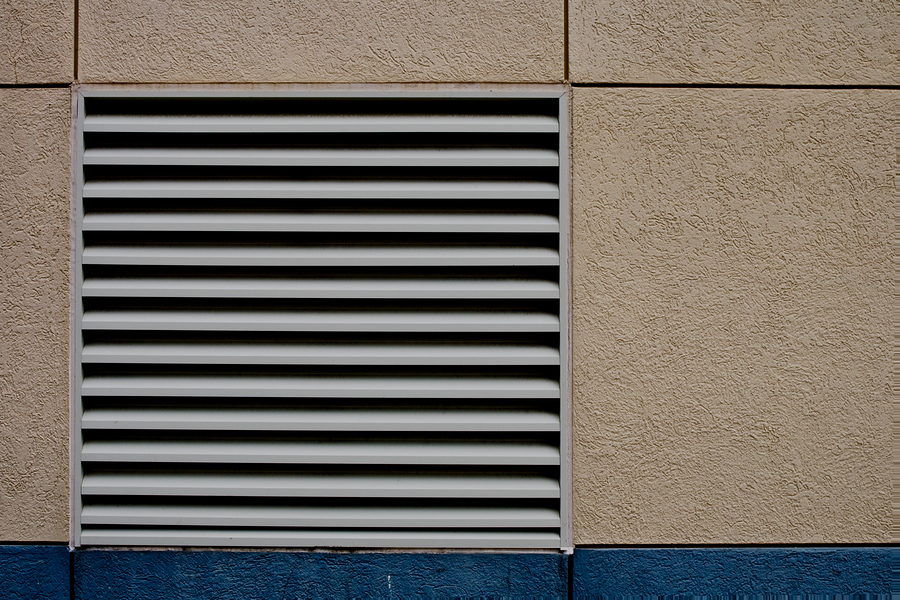
Photo © BigStockPhoto
by Kristi Duce, CCS, GGP, CSI, AIA, NCARB
Operable wall louvers offer maximum flexibility for airflow control, design, and functionality. To control airflow, these ‘adjustable’ wall louvers contain blades that typically rotate within the louver frame between fully open at a preset angle and fully closed. In some cases, the operable blades may be the only set of blades within the louver frame. In dual-blade operable (or ‘combination’) louvers, however, they are in addition to the set of fixed blades.
For cases where climate conditions preclude single louvers, dual-blade operable units allow aesthetic needs to be met while maintaining functionality and weather protection. If aesthetics is a concern due to the high visibility of a louver, a dual-blade unit with a fixed louver on the exterior can offer consistent appearance regardless of the interior blade’s position.
When severe weather is a concern, operable louvers should not be specified as a single unit, as they typically cannot withstand windborne-debris impact and are ineffective at resisting wind-driven rain. Instead, one can opt for a dual-blade model with a fixed louver capable of enduring these conditions on the exterior, and an operable blade on the interior for airflow control.
If the operable louver location makes security is a concern, a dual-blade louver can be used with a fixed-blade louver on the exterior attached with security screws or concealed fasteners. Several other combinations of dual-blade louvers are available, or one can be created by using any type of fixed blades combined with operable blades in the same frame.
The blades on operable louvers can be operated by cranks, push bars, chains, or actuator devices that are electrically, pneumatically, or hydraulically powered. The louver location and function generally dictate the operation type required.
Operable louvers can be drainable-blade or non-drainable-blade. The former is designed with gutters to collect water falling on the blade and drain it to the blade ends. There, it flows in the channels of vertical frame members to the bottom of the louver and is weeped to the exterior. Non-drainable blades, on the other hand, allow the water falling on the blade to flow down its face to the louver face and then drip off—frequently to be blown onto the blade below.
Operable louver performance is measured by the following factors:
- free area (i.e. area through which air can pass; that is, the total of the spaces between blades multiplied by the distance between jambs);
- air-performance testing (i.e. the resistance of the louver to the air flowing through it—the static-pressure drop through the louver is measured for a set of airflow velocities through the free area);
- water-penetration testing (i.e. the weight of water in grams per square meter [ounces per square foot] of free area passing from the louver’s exterior to the interior at various air-intake velocities); and
- air-leakage testing in the closed position (i.e. the volume of air per unit of face area passing through the louver at a specified pressure differential, with a stated torque holding the device in a closed position.
Energy performance is also a growing concern. To address this, some manufacturers offer insulated blades or louvers with thermally broken blades and frames, along with blade-edge and blade-jamb seals.
Galvanized-steel sheet and aluminum extrusions are the most commonly used materials for louver blades and frames. The latter is a popular choice because of its appearance, good corrosion resistance, and low fabrication cost. Other metal options include stainless steel, copper, lead-coated copper, brass, and bronze. Depending on the material, various finishes for operable louvers are also available.
If airflow control is of utmost importance, an operable wall louver is an ideal solution. When combined with fixed louvers as a dual-blade operable louver, these offer the flexibility in design and performance to meet almost any project.
 Kristi Duce, CCS, GGP, CSI, AIA, NCARB, is a MasterSpec architectural specifications writer for ARCOM. She has more than 15 years of experience in architecture, working on a variety of project types across North America, from small, complicated renovation work to multi-million-dollar new construction projects for residential, corporate, healthcare, historic preservation, retail, and educational buildings. Her experience as a project architect, project manager, and construction administrator brings an additional element of experience to her specification writing. Duce-Romero can be reached at kduce@arcomnet.com.
Kristi Duce, CCS, GGP, CSI, AIA, NCARB, is a MasterSpec architectural specifications writer for ARCOM. She has more than 15 years of experience in architecture, working on a variety of project types across North America, from small, complicated renovation work to multi-million-dollar new construction projects for residential, corporate, healthcare, historic preservation, retail, and educational buildings. Her experience as a project architect, project manager, and construction administrator brings an additional element of experience to her specification writing. Duce-Romero can be reached at kduce@arcomnet.com.





Nice article I’m interested in finding a company at 10 Supply me with a dual blade insulated Louver can you help me please?